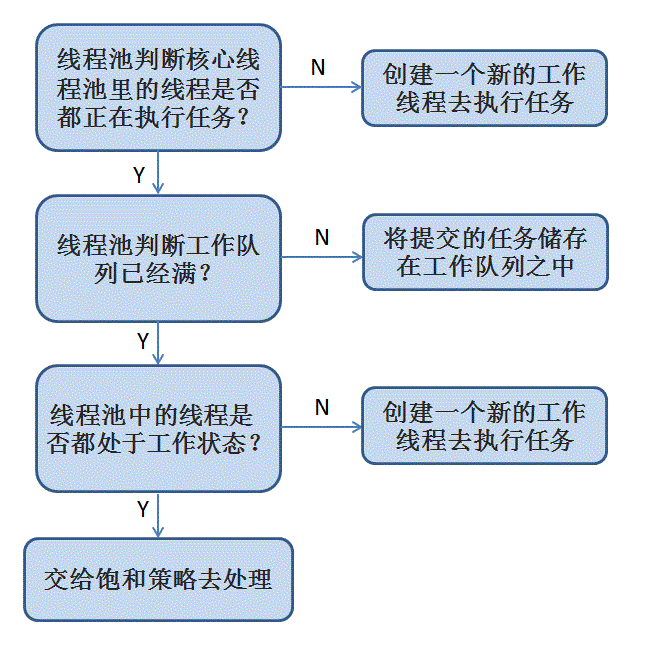
在什么情况下使用线程池?
1.单个任务处理的时间比较短
2.将需处理的任务的数量大
使用线程池的好处:
1. 降低资源消耗: 通过重复利用已创建的线程降低线程创建和销毁造成的消耗。
2. 提高响应速度: 当任务到达时,任务可以不需要等到线程创建就能立即执行。
3. 提高线程的可管理性: 线程是稀缺资源,如果无限制的创建。不仅仅会降低系统的稳定性,使用线程池可以统一分配,调优和监控。但是要做到合理的利用线程池。必须对于其实现原理了如指掌。
一个线程池包括以下四个基本组成部分:
1、线程池管理器(ThreadPool):用于创建并管理线程池,包括 创建线程池,销毁线程池,添加新任务;
2、工作线程(PoolWorker):线程池中线程,在没有任务时处于等待状态,可以循环的执行任务;
3、任务接口(Task):每个任务必须实现的接口,以供工作线程调度任务的执行,它主要规定了任务的入口,任务执行完后的收尾工作,任务的执行状态等;
4、任务队列(taskQueue):用于存放没有处理的任务。提供一种缓冲机制。
在JDK1.6中研究ThreadPoolExecutor类:
volatile int runState; static final int RUNNING = 0; static final int SHUTDOWN = 1; static final int STOP = 2; static final int TERMINATED = 3;
runState表示当前线程池的状态,它是一个volatile变量用来保证线程之间的可见性;
当创建线程池后,初始时,线程池处于RUNNING状态;
如果调用了shutdown()方法,则线程池处于SHUTDOWN状态,此时线程池不能够接受新的任务,它会等待所有任务执行完毕;
如果调用了shutdownNow()方法,则线程池处于STOP状态,此时线程池不能接受新的任务,并且会去尝试终止正在执行的任务;
当线程池处于SHUTDOWN或STOP状态,并且所有工作线程已经销毁,任务缓存队列已经清空或执行结束后,线程池被设置为TERMINATED状态。
execute方法:
public void execute(Runnable command) { if (command == null) throw new NullPointerException(); if (poolSize >= corePoolSize || !addIfUnderCorePoolSize(command)) { if (runState == RUNNING && workQueue.offer(command)) { if (runState != RUNNING || poolSize == 0) ensureQueuedTaskHandled(command); } else if (!addIfUnderMaximumPoolSize(command)) reject(command); // is shutdown or saturated } }
addIfUnderCorePoolSize方法检查如果当前线程池的大小小于配置的核心线程数,说明还可以创建新线程,则启动新的线程执行这个任务。
private boolean addIfUnderCorePoolSize(Runnable firstTask) { Thread t = null; final ReentrantLock mainLock = this.mainLock; mainLock.lock(); try { if (poolSize < corePoolSize && runState == RUNNING) t = addThread(firstTask); } finally { mainLock.unlock(); } return t != null; }
addThread:
private Thread addThread(Runnable firstTask) { Worker w = new Worker(firstTask); Thread t = threadFactory.newThread(w); boolean workerStarted = false; if (t != null) { if (t.isAlive()) // precheck that t is startable throw new IllegalThreadStateException(); w.thread = t; workers.add(w); int nt = ++poolSize; if (nt > largestPoolSize) largestPoolSize = nt; try { t.start(); workerStarted = true; } finally { if (!workerStarted) workers.remove(w); } } return t; }
Worker,在ThreadPoolExecutor中的内部类

private final class Worker implements Runnable { /** * The runLock is acquired and released surrounding each task * execution. It mainly protects against interrupts that are * intended to cancel the worker thread from instead * interrupting the task being run. */ private final ReentrantLock runLock = new ReentrantLock(); /** * Initial task to run before entering run loop. Possibly null. */ private Runnable firstTask; /** * Per thread completed task counter; accumulated * into completedTaskCount upon termination. */ volatile long completedTasks; /** * Thread this worker is running in. Acts as a final field, * but cannot be set until thread is created. */ Thread thread; /** * Records that the thread assigned to this worker has actually * executed our run() method. Such threads are the only ones * that will be interrupted. */ volatile boolean hasRun = false; Worker(Runnable firstTask) { this.firstTask = firstTask; } boolean isActive() { return runLock.isLocked(); } /** * Interrupts thread if not running a task. */ void interruptIfIdle() { final ReentrantLock runLock = this.runLock; if (runLock.tryLock()) { try { if (hasRun && thread != Thread.currentThread()) thread.interrupt(); } finally { runLock.unlock(); } } } /** * Interrupts thread even if running a task. */ void interruptNow() { if (hasRun) thread.interrupt(); } /** * Runs a single task between before/after methods. */ private void runTask(Runnable task) { final ReentrantLock runLock = this.runLock; runLock.lock(); try { /* * If pool is stopping ensure thread is interrupted; * if not, ensure thread is not interrupted. This requires * a double-check of state in case the interrupt was * cleared concurrently with a shutdownNow -- if so, * the interrupt is re-enabled. */ if ((runState >= STOP || (Thread.interrupted() && runState >= STOP)) && hasRun) thread.interrupt(); /* * Track execution state to ensure that afterExecute * is called only if task completed or threw * exception. Otherwise, the caught runtime exception * will have been thrown by afterExecute itself, in * which case we don't want to call it again. */ boolean ran = false; beforeExecute(thread, task); try { task.run(); ran = true; afterExecute(task, null); ++completedTasks; } catch (RuntimeException ex) { if (!ran) afterExecute(task, ex); throw ex; } } finally { runLock.unlock(); } } /** * Main run loop */ public void run() { try { hasRun = true; Runnable task = firstTask; firstTask = null; while (task != null || (task = getTask()) != null) { runTask(task); task = null; } } finally { workerDone(this); } } }
ensureQueuedTaskHandled:
判断如果当前状态不是RUNING,则当前任务不加入到任务队列中,判断如果状态是停止,线程数小于允许的最大数,且任务队列还不空,则加入一个新的工作线程到线程池来帮助处理还未处理完的任务。
private void ensureQueuedTaskHandled(Runnable command) { final ReentrantLock mainLock = this.mainLock; mainLock.lock(); boolean reject = false; Thread t = null; try { int state = runState; if (state != RUNNING && workQueue.remove(command)) reject = true; else if (state < STOP && poolSize < Math.max(corePoolSize, 1) && !workQueue.isEmpty()) t = addThread(null); } finally { mainLock.unlock(); } if (reject) reject(command); }
void reject(Runnable command) { handler.rejectedExecution(command, this); }
addIfUnderMaximumPoolSize:
addIfUnderMaximumPoolSize检查如果线程池的大小小于配置的最大线程数,并且任务队列已经满了(就是execute方法试图把当前线程加入任务队列时不成功),
说明现有线程已经不能支持当前的任务了,但线程池还有继续扩充的空间,就可以创建一个新的线程来处理提交的任务。
private boolean addIfUnderMaximumPoolSize(Runnable firstTask) { Thread t = null; final ReentrantLock mainLock = this.mainLock; mainLock.lock(); try { if (poolSize < maximumPoolSize && runState == RUNNING) t = addThread(firstTask); } finally { mainLock.unlock(); } return t != null; }
整个流程:
1、如果线程池的当前大小还没有达到基本大小(poolSize < corePoolSize),那么就新增加一个线程处理新提交的任务;
2、如果当前大小已经达到了基本大小,就将新提交的任务提交到阻塞队列排队,等候处理workQueue.offer(command);
3、如果队列容量已达上限,并且当前大小poolSize没有达到maximumPoolSize,那么就新增线程来处理任务;
4、如果队列已满,并且当前线程数目也已经达到上限,那么意味着线程池的处理能力已经达到了极限,此时需要拒绝新增加的任务。至于如何拒绝处理新增的任务,取决于线程池的饱和策略RejectedExecutionHandler。
================================================
设置合适的线程池大小:
如果是CPU密集型的任务,那么良好的线程个数是实际CPU处理器的个数的1倍;
如果是I/O密集型的任务,那么良好的线程个数是实际CPU处理器个数的1.5倍到2倍
线程池中线程数量:
 View Code
View Code为什么+1,与CPU核数相等,表示满核运行,+1的话表示在CPU上存在竞争,两者的竞争力不一样。稍微高一点负荷是不影响的。
http://ifeve.com/how-to-calculate-threadpool-size/
==================================================================================
Java中提供了几个Executors类的静态方法:
public static ExecutorService newFixedThreadPool(int nThreads) { return new ThreadPoolExecutor(nThreads, nThreads, 0L, TimeUnit.MILLISECONDS, new LinkedBlockingQueue<Runnable>()); } public static ExecutorService newSingleThreadExecutor() { return new FinalizableDelegatedExecutorService (new ThreadPoolExecutor(1, 1, 0L, TimeUnit.MILLISECONDS, new LinkedBlockingQueue<Runnable>())); } public static ExecutorService newCachedThreadPool() { return new ThreadPoolExecutor(0, Integer.MAX_VALUE, 60L, TimeUnit.SECONDS, new SynchronousQueue<Runnable>()); }
newFixedThreadPool创建的线程池corePoolSize和maximumPoolSize值是相等的,它使用的LinkedBlockingQueue;
newSingleThreadExecutor将corePoolSize和maximumPoolSize都设置为1,也使用的LinkedBlockingQueue;
newCachedThreadPool将corePoolSize设置为0,将maximumPoolSize设置为Integer.MAX_VALUE,使用的SynchronousQueue,也就是说来了任务就创建线程运行,当线程空闲超过60秒,就销毁线程。
任务拒绝策略:
当线程池的任务缓存队列已满并且线程池中的线程数目达到maximumPoolSize,如果还有任务到来就会采取任务拒绝策略,通常有以下四种策略:
ThreadPoolExecutor.AbortPolicy:丢弃任务并抛出RejectedExecutionException异常。
ThreadPoolExecutor.DiscardPolicy:也是丢弃任务,但是不抛出异常。
ThreadPoolExecutor.DiscardOldestPolicy:丢弃队列最前面的任务,然后重新尝试执行任务(重复此过程)
ThreadPoolExecutor.CallerRunsPolicy:由调用线程处理该任务
demo:
import java.util.concurrent.ArrayBlockingQueue; import java.util.concurrent.ThreadPoolExecutor; import java.util.concurrent.TimeUnit; public class Main { public static void main(String[] args) { ThreadPoolExecutor executor = new ThreadPoolExecutor(5, 10, 200, TimeUnit.MILLISECONDS, new ArrayBlockingQueue<Runnable>(5)); for(int i=0;i<15;i++){ MyTask myTask = new MyTask(i); executor.execute(myTask); System.out.println("线程池中线程数目:"+executor.getPoolSize()+",队列中等待执行的任务数目:"+ executor.getQueue().size()+",已执行玩别的任务数目:"+executor.getCompletedTaskCount()); } executor.shutdown(); } } class MyTask implements Runnable { private int taskNum; public MyTask(int num) { this.taskNum = num; } @Override public void run() { System.out.println("正在执行task "+taskNum); try { Thread.currentThread().sleep(0); } catch (InterruptedException e) { e.printStackTrace(); } System.out.println("task "+taskNum+"执行完毕"); } }

线程池中线程数目:1,队列中等待执行的任务数目:0,已执行玩别的任务数目:0 线程池中线程数目:2,队列中等待执行的任务数目:0,已执行玩别的任务数目:0 线程池中线程数目:3,队列中等待执行的任务数目:0,已执行玩别的任务数目:0 正在执行task 0 线程池中线程数目:4,队列中等待执行的任务数目:0,已执行玩别的任务数目:0 正在执行task 3 正在执行task 1 task 3执行完毕 task 1执行完毕 线程池中线程数目:5,队列中等待执行的任务数目:0,已执行玩别的任务数目:0 task 0执行完毕 正在执行task 5 线程池中线程数目:5,队列中等待执行的任务数目:1,已执行玩别的任务数目:2 线程池中线程数目:5,队列中等待执行的任务数目:1,已执行玩别的任务数目:3 线程池中线程数目:5,队列中等待执行的任务数目:2,已执行玩别的任务数目:3 线程池中线程数目:5,队列中等待执行的任务数目:3,已执行玩别的任务数目:3 线程池中线程数目:5,队列中等待执行的任务数目:4,已执行玩别的任务数目:3 线程池中线程数目:5,队列中等待执行的任务数目:5,已执行玩别的任务数目:3 task 5执行完毕 正在执行task 6 task 6执行完毕 正在执行task 7 task 7执行完毕 正在执行task 8 task 8执行完毕 正在执行task 9 task 9执行完毕 正在执行task 10 task 10执行完毕 线程池中线程数目:6,队列中等待执行的任务数目:0,已执行玩别的任务数目:9 线程池中线程数目:6,队列中等待执行的任务数目:1,已执行玩别的任务数目:9 线程池中线程数目:6,队列中等待执行的任务数目:2,已执行玩别的任务数目:9 线程池中线程数目:6,队列中等待执行的任务数目:3,已执行玩别的任务数目:9 正在执行task 12 正在执行task 14 正在执行task 13 task 14执行完毕 task 13执行完毕 task 12执行完毕 正在执行task 2 task 2执行完毕 正在执行task 4 task 4执行完毕 正在执行task 11 task 11执行完毕
http://www.ibm.com/developerworks/cn/java/j-jtp0730/
http://www.cnblogs.com/dolphin0520/p/3932921.html
http://www.cnblogs.com/guguli/p/5198894.html
http://www.infoq.com/cn/articles/executor-framework-thread-pool-task-execution-part-01/
http://blog.csdn.net/aitangyong/article/details/38842643?utm_source=tuicool&utm_medium=referral
